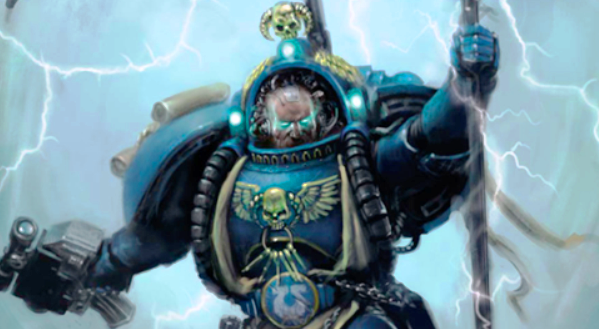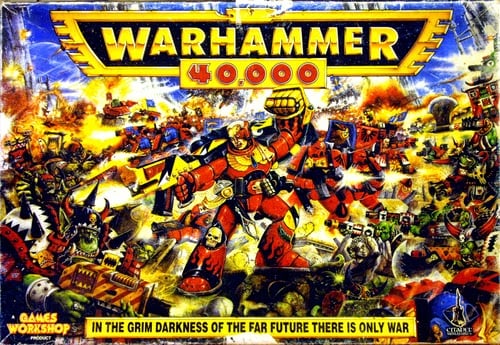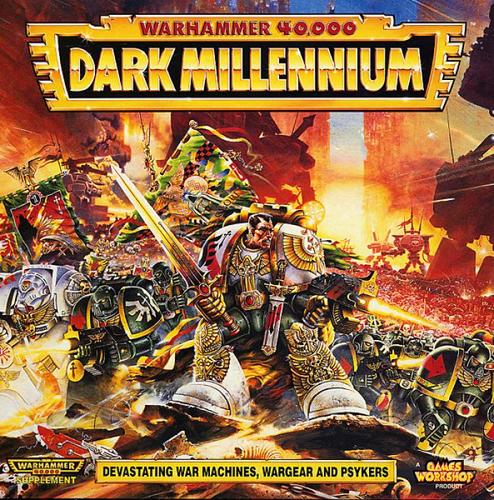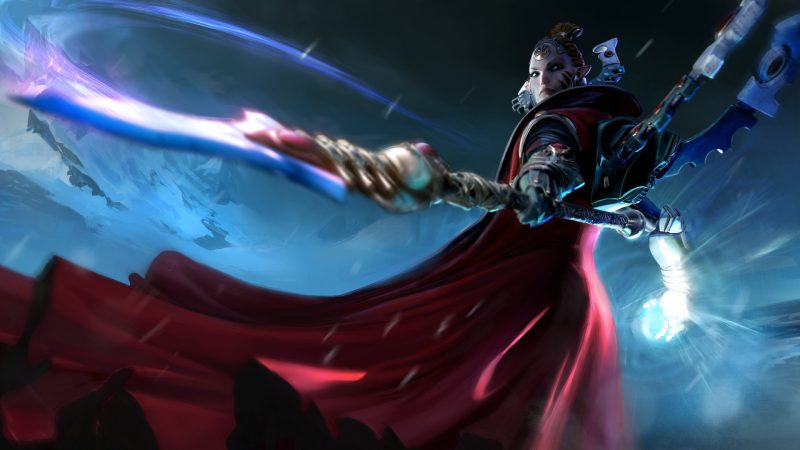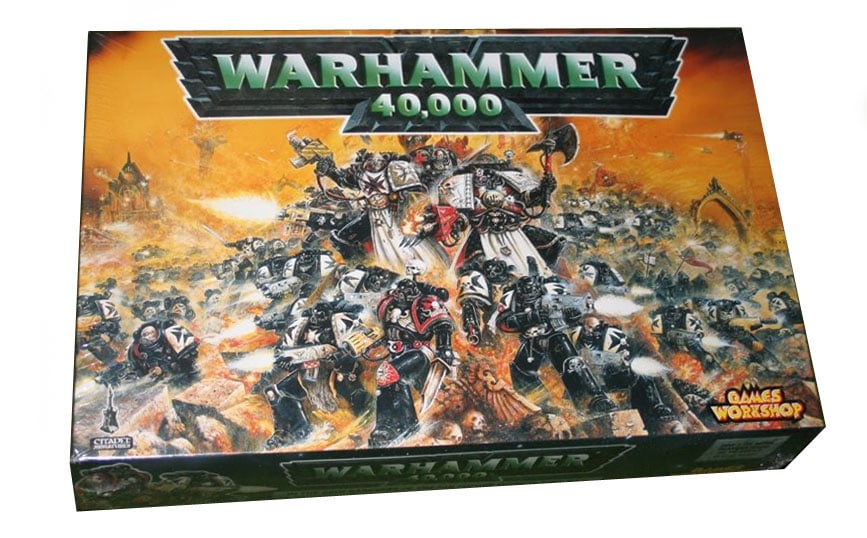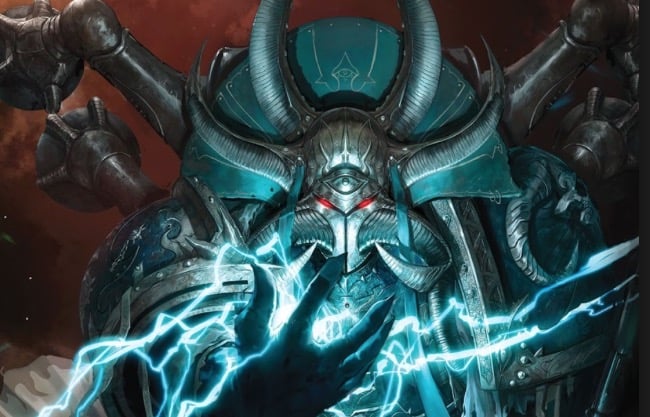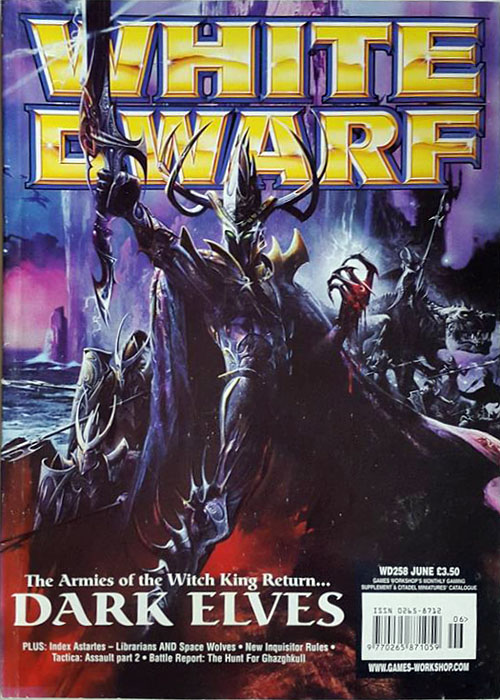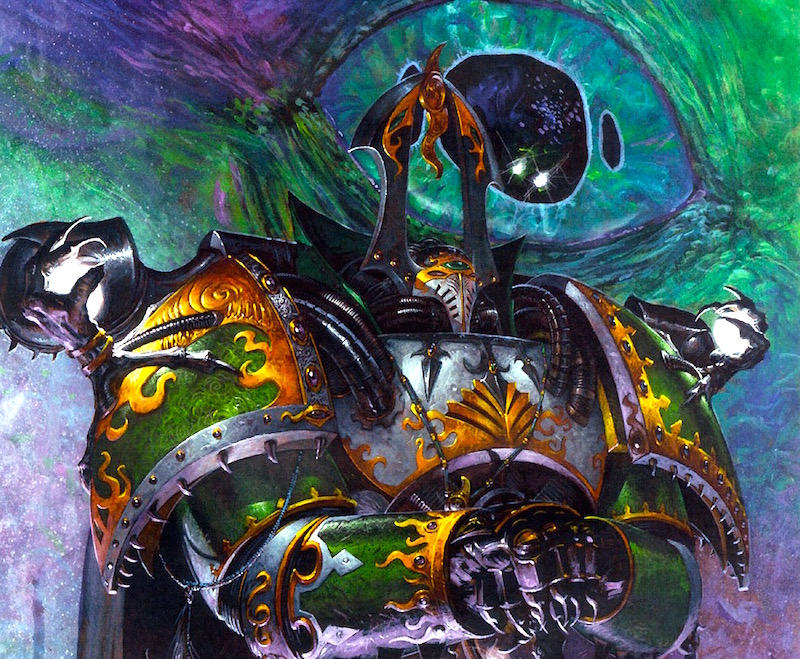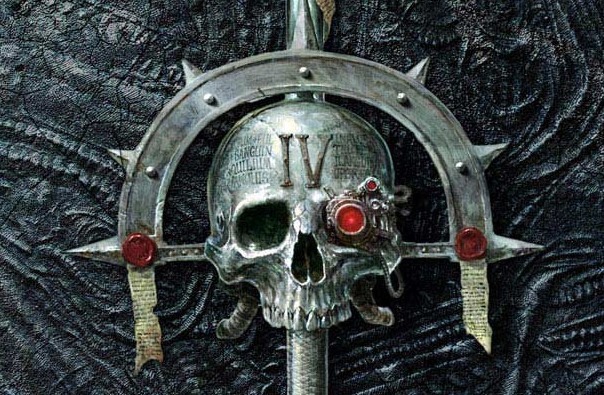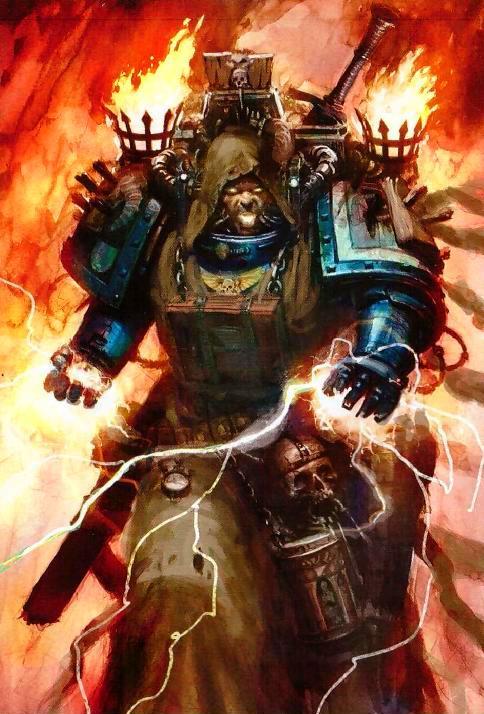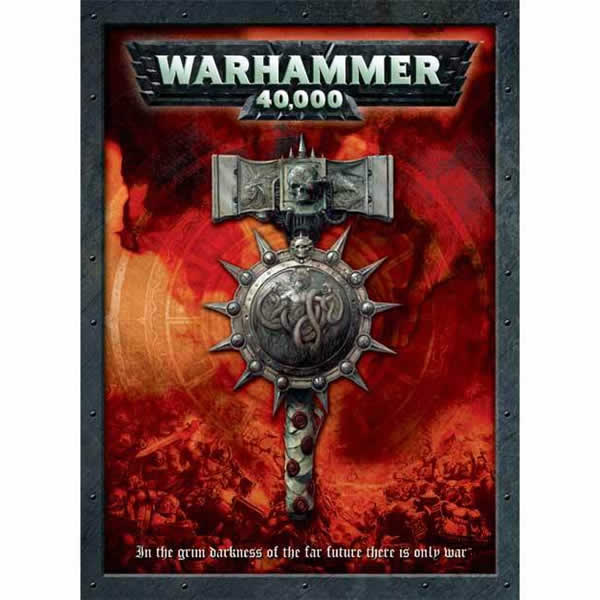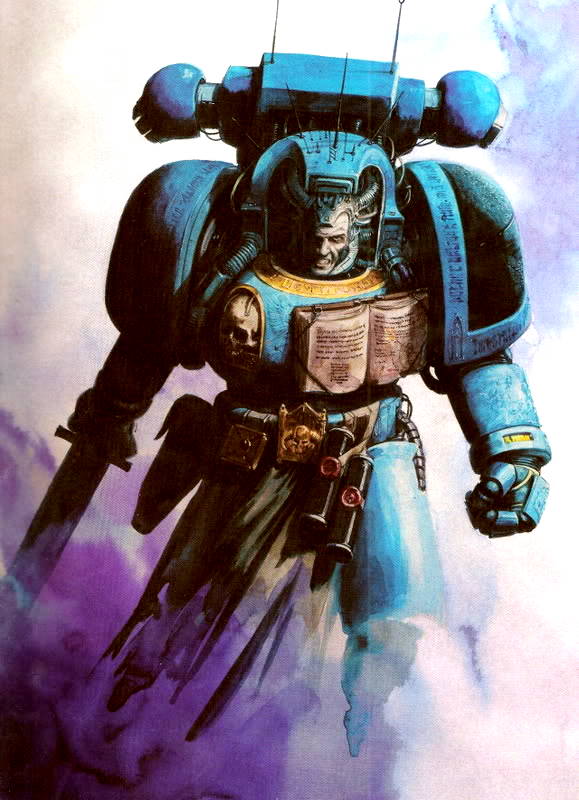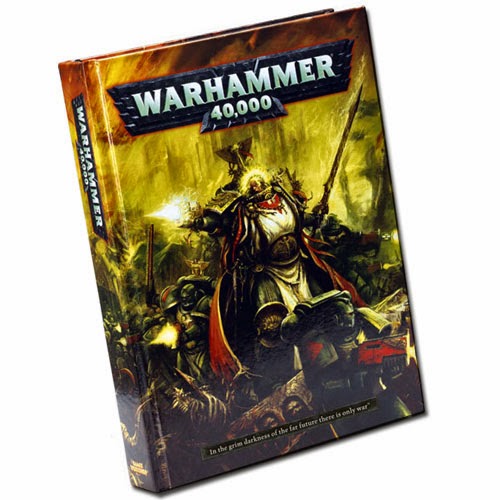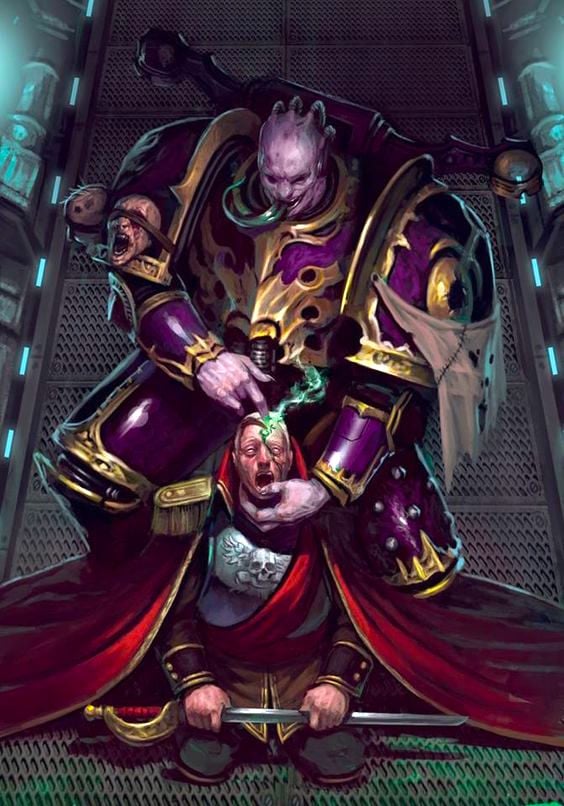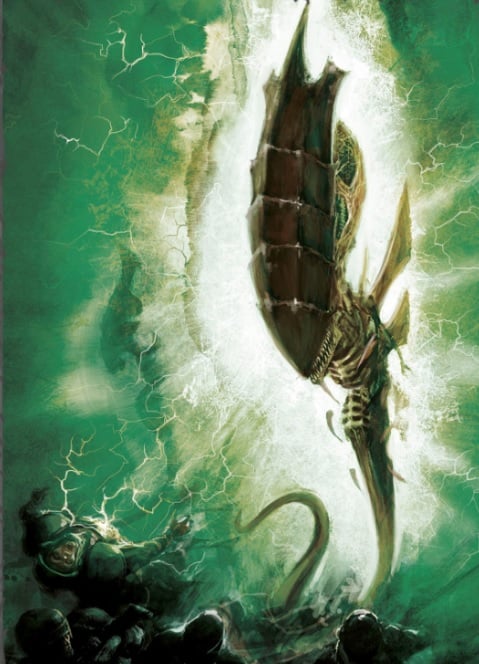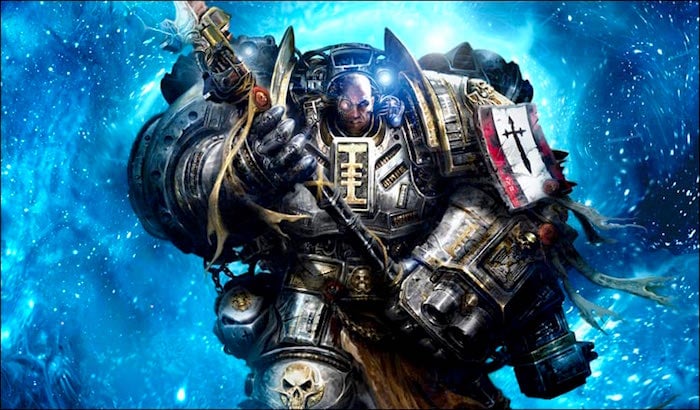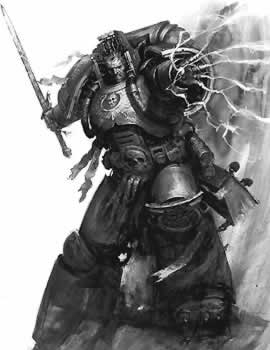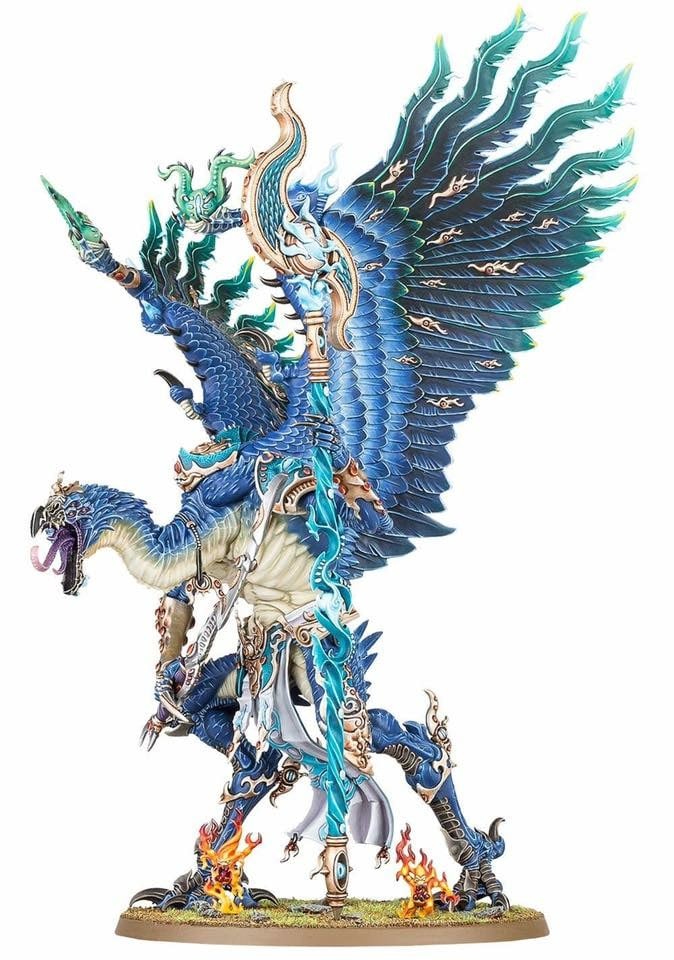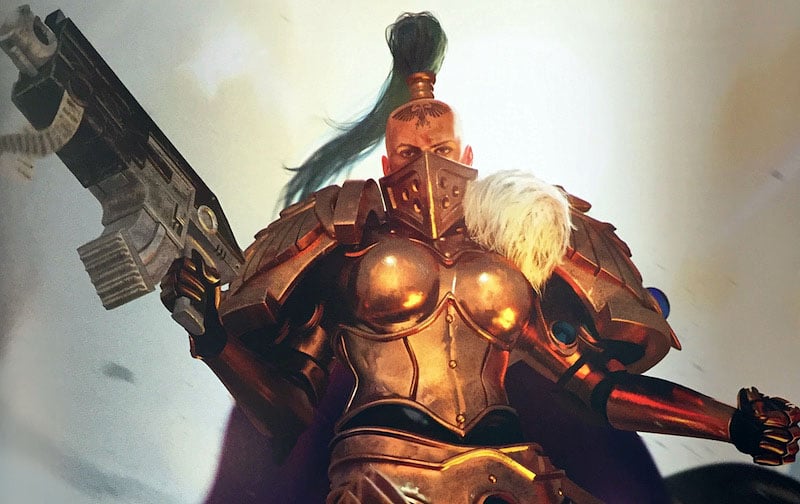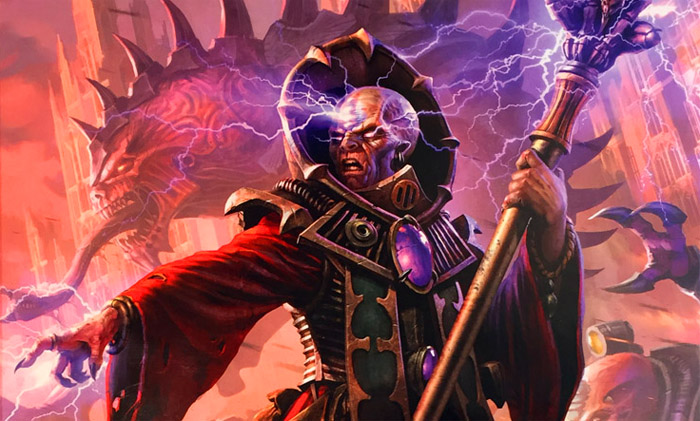Psyched Out! The Evolution of 40K’s Psychic Phase


Michael Corr here, taking a look at the history of the psychic phase in 40k and how it has evolved over the years.
For more reviews, analyses and battle reports, check out the Tactics Corner.
The Warp, the parallel dimension that is a swirling maelstrom of energy, has been an integral part of the 40k lore for a long time now. It provides the basis of interstellar travel for many of the races of the 40k universe, and it is often said that without the Warp’s ability to travel vast distances in (relative) safety, the Imperium of Mankind would crumble in no time. This chaotic dimension also provides energy to the psykers of the 40k universe, imbuing them with vast power to unleash their arts on the enemy.
The psychic phase has seen substantial changes over the various editions of 40k. Indeed, for several editions of the game, no such phase existed in the turn sequence. I don’t tend to run psychic heavy armies, the reasons for which I will get to as the article proceeds, but there is no doubt that the addition of psykers to the 40k tabletop can have a dramatic effect on the course of the battle.
Second Edition (1993-1998)- Pick a Card, Any Card……
As with much of the game, the psychic phase was a very different beast in second edition.
The Main Book
A version of the rules for the psychic phase was included in the main rulebook for 2nd edition 40k- the Psionics section.
This section provided some simplified rules for using psykers in games of 40k. It gave the four different mastery levels for psykers and provided 6 psychic powers that they could choose from at the start of the game.
In order to cast a psychic power, the player had to roll above the casting value on the power and were able to add the mastery level of the psyker to the die roll. Rolls of a 1 always failed when casting, but with a highest casting level of 6, level 4 psykers has a 1 in 6 chance of successfully using a psychic power each turn. Each psyker could only use one power per turn, regardless of their mastery level.
One of the example psychic powers in the rulebook was psychic shield. Cast on a 3+, this power provided the psyker with the equivalent of a 3+ invulnerable save against shooting and close combat wounds. Against psychic attacks or powers, it provided a 4+ invulnerable save. The shield remained in effect until it was used to block a psychic attack.
Much like the close combat phase, both players took part in the psychic phase. The player whose turn it was could attempt to use a psychic power from one of their psykers, then their opponent could attempt to use a power from one of their psykers. This continued until no more psykers remained.
The psionics section also included the rules for Force weapons. In 2nd edition, the psyker got to add their mastery level to the strength of their attack in combat when using a force weapon. As armour saves were modified by the strength of the attacker, this meant that a powerful psyker could cut through power armoured models with ease.
Daemons were said to be especially vulnerable to Force weapons- any attack from a force weapon that hit a Daemon in combat automatically wounded and ignored their saving throw. This made psykers a very powerful unit for taking on daemonic units in combat.
Supplementing Your Power- Dark Millennium (1994)
Not long after the release of the 2nd edition of Warhammer 40,000, GW released an expansion providing more detailed rules for psychic powers, wargear and vehicles.
Dark Millennium provided a new, more interactive version of the psychic phase for 40k.
The psychic powers were split into 10 different decks, each with 4-8 psychic powers that could be used. Psykers were able to take one psychic power per mastery level they had. Psykers were given a list of powers they could choose from, split into their Primary Discipline and Tertiary Disciplines. For example, a Space Marine Librarian’s primary discipline was from a deck called Librarian Powers. Their tertiary disciplines were chosen from the Inquisition and Adeptus powers decks.
Psykers had to take at least one power from their primary discipline, but were free to draw random cards from their tertiary disciplines too, up to their mastery level. The way that powers were drawn was also unusual compared to todays standards; All primary discipline powers were dealt first, starting with the highest mastery level. Tertiary powers were then dealt to the players, again starting with the highest mastery level. If 2 or more psykers had the same mastery level, players would roll off and the winner would receive the powers first. This meant that if there were enough psykers in a battle, some would receive no powers at all if the deck was used up before they had the chance to draw cards.
Another big difference is that psychic powers were kept secret and were not revealed until they were used. This meant that you could never be sure which powers your opponent’s psykers were armed with, therefore which units they could threaten or boost. This was an interesting rule and would certainly make for some interesting games if it was used today.
The Psychic Phase
In second edition, the psychic phase took place at the end of turn and involved the use of a number of different cards.
The warp flux was determined by rolling 2D6 and dealing that number of cards between the players. As in the main rulebook, players used psychic powers in an alternating fashion, starting with the players whose turn it was. Each psychic power could only be used once, but the psyker was able to cast all his psychic powers in a turn if he was able to.
Players were able to cast or block psychic powers based on the different cards that they were dealt:
- FORCE CARD- These were used to power psychic abilities. Players would need to play enough force cards to meet the “casting value” of each power.
- NULLIFY- These could be used to block psychic powers. The card was played and on a roll of 4+, the power was stopped. Players were allowed to use as many nullify cards as they had in their possession to block a power. Players received a bonus or penalty to the roll depending on whether or not there were more or less powerful psykers attempting the block.
- DESTROY POWER- This gave players the chance to destroy an enemy psyker’s power.
- ENERGY DRAIN- This removed all the cards from both players hands that turn and nullified any powers currently in play.
- REFLECTION- Powers were reflected 4D6″ back towards the psyker.
- DAEMONIC ATTACK- Nullified a power and gave a 50% chance that the psyker would be removed from play.
- PSYCHIC DUEL- Players would roll a D6 and add the mastery level of their psykers. The loser would lose one random psychic power.
- ULTIMATE FORCE- The psychic power could not be blocked.
Psykers were able to use their powers in combat without any penalty. The expansion also provided additional rule for Ork psykers to cover the unusual rules that Weirdboyz had when dealing with psychic abilities.
An example psychic power was Smite from the Librarian psychic discipline. This was a Force 3 power that was a psychic attack on the enemy unit. It was essentially a 2″ blast attack with a range of 24″. Any model under the template had to take a Leadership test with a -2 penalty. If they failed, the model suffered instant death with no armour saves allowed. A pretty powerful psychic attack.
I never played 40k in second edition, but did play Fantasy in 5th edition. It had a very similar system of magic (though with a few key differences). I always enjoyed the magic phase in fantasy using the winds of magic cards. It almost felt like a mini-game each turn in your regular fantasy game. I imagine the 40k psychic phase was a similar experience.
The idea of both players getting to use their powers in the one phase is quite unusual based on the more recent editions. This was more common in second edition where both players could be more involved in each other’s turns thanks to the way combat and overwatch firing worked.
Third Edition (1998-2004)- Powered Down
As with many things in 40k, the psychic phase was dramatically simplified in the move from second edition to third edition. In fact, the psychic phase was removed from the turn sequence entirely in 3rd edition.
Leadership in Peril
The toned down rules for psykers were much simpler, with powers being easier to cast but significantly less game changing than they could be in 2nd edition.
Each psyker could cast one psychic power per turn and powers were cast by passing a leadership test based on the Psyker’s leadership. Simple, easy, done. Psychic attacks were subject to the normal shooting restrictions, so could not be used in combat (if they were a shooting attack).
The instability of the warp was introduced by subjecting Psykers to the Perils of the Warp. If the leadership test roll came up a natural 2 or 12, the psyker would take a strength D6 hit with no saves allowed. Not a huge disadvantage in casting psychic powers; multi-wound psykers had little to fear from a Perils roll when casting a power until they reached their final wound.
The phase in which a psyker used their powers depended on the type of power being used. For example, the 3rd edition rulebook featured two psychic powers for Space Marine Librarians; Smite and Storm of Destruction. Smite was a shooting attack (range 12″, S4, AP2, Assault 1/Blast), so was used in the shooting phase and had the normal restrictions for shooting attacks. Storm of Destruction was used in the close combat phase and allowed the psyker to re-roll all missed attacks in combat.
As it result of this, it was easy to forget to use your psychic powers at the correct time or have to do them out of sequence (assuming your opponent was kind enough to allow you to do so) if you were not used to running psykers on a regular basis.
I don’t recall running a Librarian very often with my Dark Angels during 3rd edition. From my quite hazy memory, they were ok, but were outclassed by an Interrogator-Chaplain as my standard HQ unit.
Expansion of Power (White Dwarf 258)
About half way through 3rd edition’s lifetime, expanded psychic powers were introduced in White Dwarf.
“It’s sad really- once upon a time (back in the days of Rogue Trader and the second edition of Warhammer 40,000) psykers were the supreme nasties of the 41st millennium- their warp-spawned powers were capable of laying waste to entire armies and sub-continents. Such rampant overkill couldn’t last of course; in the third edition of the game sanity prevailed and we deliberately toned down the abilities of psykers to far more mortal levels. This worked fine, and now you can have battles between armies who don’t have to fear instant vapourisation by some ravening, extra-planar megadeath power unleashed at the end of turn one.
Unfortunately when you wield the knife you sometimes cut a little too deep, and now most peoples’ Space Marine Librarians and Chaos Sorcerers have been relegated to the reserves bench in favour of less costly Chaplains and other chainsword wielding lunatics. In retrospect, bringing the psychic powers under control actually made psykers too staid and predictable to be really interesting any more. Some time ago this nagging feeling led me to start pulling together some ideas for additional psychic powers that could be added in order to give the psykers back some zest“- Andy Chambers, It’s All in the Mind, White Dwarf 258.
Space Marine Librarians, Chaos Space Marine Sorcerers and Sorcerer Lords, and Daemon Princes were able to purchase additional psychic powers for 15 pts each. The cost came from their wargear allowance, so there were limits on how many powers each psyker could purchase.
The new psychic powers were listed as optional- only for use in agreement with your opponent, but added some more flavour to some of the psykers in the game. The powers were split into 5 different tables; Telekinetic, Movement, Temporal, Enhancement and Will psychic powers. One or more powers could be purchased from a table and the power was randomly generated before the start of the game. Four of the five tables had a roll of a 1 resulting in no useful power, so purchasing new powers for your psyker was not entirely without risk.
An example of each of the psychic powers for the different tables is shown below:
- TELEKINETIC- Protect (Range 12″). Used in the enemy shooting phase, this provided one unit in range with a 6+ invulnerable save.
- MOVEMENT- Relentless (Range 6″). One unit in range counts as stationary for firing rapid fire and pistol weapons.
- TEMPORAL- Slow Time. All models in base contact with the psyker count as Initiative 1.
- ENHANCEMENT- Iron Fist. The psyker gains +1 strength.
- WILL- Inspire. The psyker gains +1 Leadership.
The new psychic powers added a bit more variety to using psykers in 3rd edition, but were not overpowered or game changing on their own.
Nine months later, White Dwarf also introduced new Chaos minor psychic powers for Tzeentch, Nurgle and Slaanesh. Each power cost 10 pts and the user had to bear the mark of their patron god. The article also included a preview of the new psychic powers that were to appear in the next Chaos Codex.
Fourth Edition (2004-2008)- More Power, More Peril
The next edition of 40k did not see any dramatic changes to the rules for psykers. The major changes came within the Codices themselves, with psykers generally seeing an expansion of their abilities.
Psychic tests remained unchanged, requiring a Leadership test for successful use of a power. Perils of the warp still occurred on a 2 or 12, but the Peril caused an automatic strength 6 hit with no saves allowed. A roll of a 2 meant that the power would still work, even if the psyker was killed by the Perils wound.
Power Surge
Many psykers saw an increase in the number of powers that they could access and their abilities in their codices. For example, the Space Marine Librarian for 4th edition contained two levels of psyker; Epistolary and Codicier. The Codicier had one psychic power, while the Epistolary could take two psychic powers.
The number of powers that a Space Marine Librarian had access to also increased from one to six. The basic power was Storm of the Emperor’s Wrath (range 12″, S4, AP2, Assault 1/Blast), the same as Smite from the previous edition’s codex. This power could be exchanged for any of the others by paying an additional points cost, depending on what the power was.
The other powers were used in either the movement, shooting or assault phases. They consisted of shooting attacks, forcing Leadership tests on your opponent, additional attacks, re-rolls and a pseudo D weapon-type attack.
The rules for Psychic Hoods for Space Marine Librarians provided one of the few means of nullifying psychic powers in the game. Both players would roll a D6 and add their respective Leaderships. If the Librarian had the highest roll, the power would be nullified. With its unlimited range and a Leadership of 9 or 10, Space Marine Librarians had a good chance of shutting down or severely hindering an opponent’s psychic powers in 4th edition.
In the fourth edition of the game, the main rules for psykers did not change much from 3rd edition. More variety for psykers and psychic powers were introduced in many of the different race’s codices, providing much more utility for psykers in the game.
Fifth Edition (2008-2012)- Much of the Same
A few minor changes were made to the psychic phase from 4th edition to 5th edition.
The basic rules for the use of psychic powers remained unchanged. Psykers were allowed to use one power per turn and still used a Leadership test to determine if the power was successful. The penalties for Perils of the Warp increased from 4th edition. Any psyker suffer a Perils took an automatic wound, with no armour or cover saves allowed. Invulnerable saves were allowed, but any successful saves had to be re-rolled (to represent the crushing power of the attack).
Any psychic shooting attacks were specified to count as a ranged weapon, meaning the psyker and his unit could only assault the unit it fired upon
Some armies saw an expansion to the powers available for their psykers. For example, Space Marine Librarians now had access to 9 different psychic powers and were able to pick two from the list to use during a game. A Librarian could use one psychic power per turn, but if they were upgraded to an Epistolary, they were able to use two powers per turn, effectively doubling the utility of the psyker.
The standard Librarian power Smite saw a change in its profile, moving from Assault 1/Blast to Assault 4, potentially giving it more shots against widely-spaced units or single models than the previous blast version. The other powers available featured a mix of shooting attacks, invulnerable saves, combat boosting abilities and movement powers.
The psychic hood also saw some modification, with the range being reduced from table-wide to 24″. This still gave the Librarian a good bubble for blocking psychic powers, but meant that the Librarian would need to get closer to the enemy psykers to have full effect.
Sixth Edition (2012-2014)- Charging up to Deny the Witch
The next edition of the game saw big changes to the rules for psychic powers in 40k. Much more expansive rules for psykers were introduced as well as a range of new psychic powers being introduced in the main rulebook.
Mastery of your Psykers
In 6th edition, psykers were given mastery levels of between 1 and 4, indicating how many psychic powers they knew and how much warp charge they generated each turn.
Warp charge was a new concept introduced in this edition of the game. Each psyker in your army generated warp charge equal to their mastery level. These warp charges were used to cast the different psychic powers in the game, most of which were either warp charge one or two.
In order to use a psychic power, a player had to expend the appropriate number of warp charges, then take a Leadership test. If the test was passed, the power was cast. As with previous editions, a roll of a 2 or 12 on the leadership test resulted in a Perils of the Warp; the psyker taking a single wound with no saves of any kind allowed. Psykers could only attempt to use each power once and could use a power if they were falling back or had gone to ground.
Powers were still used in different phases of the game, depending on the type of psychic power being used. As such, powers that needed to be cast at the beginning of the turn could not be used by psykers that had arrived from reserve that turn.
Denying your Power
For the first time since 2nd edition, all players were given the chance to block psychic powers through a Deny the Witch roll. On a roll of a 6, your opponent’s psychic power was nullified, with bonuses for having psykers in the target unit or through special rules such as Adamantium Will.
This was a big boost for many armies, as previously the only way to block psychic powers was through wargear such as the Psychic Hood or abilities such as the Tyranid’s Shadow in the Warp. The new Deny the Witch rule gave a 1 in 6 chance of blocking your opponent’s psychic abilities where little existed before, a nice change for many players.
The range of a Space Marine Librarian’s psychic hood was decreased to 6″ and allowed the Librarian to attempt Deny rolls within this range.
New Powers Tables
Sixth edition also saw the introduction of a whole range of new psychic powers that could be used. These were split into 5 new psychic disciplines; Biomancy, Divination, Pyromancy, Telekinesis and Telepathy.
Each psyker would randomly generate their powers from one or more of the tables and many armies featured race specific psychic powers in the codices. If the power rolled had a higher warp charge than the psyker was capable of generating, they were allowed to re-roll. Each table also had a Primaris power that could be exchanged for any power rolled on that table immediately after it was rolled.
The types of powers were also more defined, with abilities split into blessings, conjurations, maledictions and witchfire powers. The concept of focussed witchfire powers was also introduced. If the casting roll (Leadership test) was a 5 or higher, the psyker was able to choose the target of the witchfire power. This allowed for “sniping” of special weapons or characters within a unit.
Big Changes
Not since 2nd edition to 3rd edition had the use of psykers in 40k seen such a substantial change. I remember my games of 6th edition seeing much more regular use of psykers, both in my own army and against many of my opponents at the time.
I liked Divination myself, with the Dark Angels Librarians being able to access the table, while regular Space Marine Librarians were unable to do so. This was one of the few bonuses that Dark Angels had over regular Space Marines in 6th edition.
Prescience was relatively easy to cast with a level 2 Librarian and the power could be guaranteed as it was the Primaris. Combined with the Banner of Devastation (or Bolter Banner as it was affectionately known) and a few units of tactical marines, it was quite literally devastating.
Biomancy was very useful for Tyranid Monstrous Creatures and Greater Daemons. I remember several games where my opponent’s Great Unclean One would get Iron Arm (+D3 toughness and strength) and becoming practically invincible thanks to the bonuses.
Invisibility was a weak shell of its current version (which we will come on to). A warp charge 2 power, it granted a unit Stealth and Shrouded (for a 4+ cover save in the open) and made an enemy unit attack them at WS1 in combat.
I mostly stuck to Divination for my Dark Angels Librarian or Imperial Guard Psykers in 6th edition, as Prescience was simply too good a power for firepower-heavy armies. There were a few other powers that were useful to get on the table, but these were regarded simply as a bonus in addition to Prescience.
Some armies became incredibly powerful for psykers under the new rules. Daemons, Grey Knights and Eldar could generate a large number of warp charge dice each turn. A popular tactic was to use a number of low level, cheaper psykers who could “funnel” their warp charge to more powerful psykers who could generally use more powerful psychic abilities.
As much as 6th edition changed the rules and the role of psykers in 40k, seventh edition was about to change the rules even further to make psykers even more powerful and a mainstay for many competitive armies.
Seventh Edition (2014 onwards)- Dicing with Daemonology
One of the biggest changes to the rules for 40k in 7th edition was the reintroduction of the psychic phase, which had been absent for over 15 years.
Return of the Phase
The new psychic phase was introduced, taking place between the movement phase and shooting phase. This was similar to the changes for fantasy in 6th edition, making the magic phase an integral part of the game rather than just something tacked on at the end of the turn.
This allowed psykers to become more involved in the game and helped to prevent players from forgetting to use powers at specific parts of the turn or in different phases of the turn as all psychic powers are now cast in the psychic phase (though if you are like me, you will still frequently forget entirely about your psychic phase and remember it about two units into your shooting phase). These changes also allowed psykers that had just arrived from reserve that turn to cast many powers that they were prevented from doing before (as they had to be cast at the start of the turn). The rules for Witchfire powers were also altered, so that psykers and their unit were no longer restricted to shooting at and assaulting a unit that the psyker had targeted with Witchfire powers.
Mastering your Charge
Another major change to the psychic phase is the way that warp charges are generated in your army.
Each player generates D6 plus the sum of their mastery levels in the army for their warp charge pool each turn. Players are allowed to manifest psychic powers until they run out of warp charge dice.
In order to use a power, a player will roll a die for each warp charge from the pool that they decide to use. Each 4+ on the dice roll manifests one successful warp charge, with players needing to equal or beat the warp charge cost of the power for it to be successful (e.g. a warp charge two power would need two successful warp charge manifestations on a 4+). Rolling two or more 6’s results in a Perils of the Warp roll on the new Perils table. This new table has a variety of results, ranging from the psyker being removed to taking wounds or to actually getting a bonus to their stats and abilities.
Players are also given the opportunity to block psychic powers with a Deny the Witch roll. They can roll any number of dice in their warp charge pool to try and block the psychic power, with each roll of a 6 negating one of your opponent’s warp charge points. Players would need to negate all successful warp charge points to block a power, not just take it below the casting level (I’ve had issues with this at the start of 7th edition where opponents would think you would simply need to negate enough warp charge to take it below the casting value. Fortunately, as 7th has gone on this issue comes up less and less).
Players trying to block psychic powers get bonuses if there are psykers in the target unit or they have special rules such as Adamantium will. The new system makes it easier to block level 1 powers than previous Deny the Witch rolls, as you can roll multiple dice and only need to come up with one 6 to block the power (in most cases). It gets more difficult to block higher level psychic powers, especially if you don’t have access to a large pool of warp charge dice, but I guess this is supposed to be balanced by the chances of periling on trying to cast higher level powers. The range of the Psychic Hood was also increased to 12″ in seventh edition.
The powers were also classified as Blessing, Conjurations, Maledictions, Witchfire power, with various sub-types within each power.
Dabbling with Daemonology
Another major change to the rules for psykers with 7th edition was the introduction of Malefic and Sanctic Daemonology powers.
The powers were primarily aimed at the Grey Knights (Sanctic powers) and Daemons (Malefic powers), but other armies are allowed to use the powers with some additional penalties; Any roll of a double for manifesting a power on the daemonology tables results in a Perils. Grey Knights and Daemons are not subject to this rule for their respective tables.
For me, the Malefic powers are the more powerful of the two daemonology tables. The ability to summon additional units to the battlefield has very few drawbacks in most missions (only where kill points are concerned could this be a slight disadvantage). In an objective-based game, the ability to summon scoring units is huge, allowing you to grab objectives more easily, especially in maelstrom missions where units can be summoned from large distances.
I guess that I am fortunate that I have only ever faced malefic daemonology when playing against Chaos Space Marines or Chaos Daemons, with their thematic summoning of daemons, rather than other forces using the deck to boost their forces with newly summoned units.
The power of malefic daemonology in summoning units has led many players and tournament organisers to attempt to “comp” the deck by outright banning it for all armies but Chaos Space Marines and Chaos Daemons or strongly suggesting that players not use the powers.
The Invisibility Dilemma
It is somewhat ironic that Invisibility is one of the most prominent, discussed and controversial of the psychic powers in 7th edition.
Invisibility got a huge boost from 6th to 7th edition and is arguably the most powerful psychic power in the game. The power went from providing Stealth and Shrouded to a unit and being hit with WS1 in combat, to the enemy firing at the unit with snap shots only and hit with 6’s in combat.
Invisibility is a huge power for any unit cast upon it, making them highly durable. It is a very important power for many “Deathstars” in the game, making already tough units nigh-on unkillable. It is one of the few game-changing powers present in the rulebook, having a dramatic effect upon any game in which it is involved.
Again, community comp has generally been levelled against Invisibility. One of the most common “fixes” that I have seen is to change invisibility so that enemy units fire at the affected unit with BS1 rather than snap shots. This means that units are still hit on a 6, but can now be affected by blast and template weapons. Other tournaments have outright banned the power due to its effect on the game.
Without a doubt, Invisibility is an insanely powerful psychic power, possibly even over-powered, but many have argued that with an edition that is pushing superheavy vehicles (particularly Imperial Knights), Gargantuan creatures such as the Wraithknight and D weapons in ‘normal’ units, Invisibility is the perfect counter to such introductions to the game and is the best defence against units such D-scythe toting Wraithguard who can chew through almost any unit with impunity.
Psyker Units
Seventh edition has also seen the rise of psyker formations such as the Seer Council or the Librarius Conclave. These types of units provide bonuses to casting for members of the formation, usually in the form of bonuses to their harnessing warp charge when in close proximity to other members of the formation or the ability to share psychic powers between psykers.
These types of formations make it easier to cast the tricky warp charge 2 powers and the close to impossible (at least for me) warp charge 3 and above powers.
Powerful Armies
Obviously armies that can take large numbers of psykers or psychic units are going to be very powerful in the psychic phase.
Grey Knights and Daemons are great psyker armies, in that most of their basic units are able to generate warp charge and psychic powers. This leads them to build up a large pool of warp charge dice each turn to either swamp their opponents psychic defences or shut down their opponent’s powers through the sheer amount of dice they can put into Deny the Witch rolls.
For me though, the Eldar are still the undisputed kings of the psychic phase. With the release of 7th edition, Eldar had access to malefic daemonology. The additional perils dangers for the Eldar using daemonology were pretty much negated for much of the table as the Ghosthelm would allow the Farseer to ignore any wounds from perils by simply expending an extra warp charge die. There were many reports of the already top tier Eldar using malefic daemonology to supplement their powers and become even stronger tournament armies.
The release of the 7th edition Eldar codex saw them no longer able to access malefic daemonology (in one of the few decreases in power that the codex saw), but they are still a potent force in the psychic phase due to the psykers available and the wargear/powers they can access. A Farseer’s ability to re-roll a single psychic test per turn and the Ghosthelms abilities means that they can routinely cast high level psychic powers with fewer chances of suffering the effects of perils of the warp.
Another common comp to mitigate psychic heavy armies is to limit the number of warp charge dice that can be generated each turn. I have seen several versions of comp for this, the most popular being a maxium of 18 power dice per turn or a maximum of 12 dice generated plus the D6 for psychic phase.
Angels of Death
Space Marine players got a big boost to their psykers with the release of the Angels of Death supplement. This saw four new psychic disciplines introduced for use by Librarians, and featured a whole host of powerful (some would say overpowered) abilities added to an already powerful force.
Veil of Time allowed players to re-roll all failed saving throws. On a tooled-up Deathstar, this make an already tough unit functionally invincible in many cases.
Electrodisplacement allowed two units up to 24” away to swap positions. The two units could still fire and assault. This was an incredibly powerful ability, all but ensuring a first turn charge with your killy unit of death if you were able to cast it. The ability was so powerful that the ITC community voted to limit the power, with the teleporting unit counting as Deep Striking, so preventing them from assaulting.
Shifting Worldscape was the height of the new psychic power madness. This power allowed you to re-shape the battlefield to your whims, as it allows you to move terrain pieces up to 24” on the table. This power was banned by the ITC, and at many other tournaments, for competitive play, simply due to the logistical nightmare it would create in tournament games.
Redressing the Balance
The new 7th edition FAQs helped to temper the use of psychic powers in 40k. One ruling was that psykers are now limited to only casting a number of powers equal to their Mastery level. This helped to limit the number of powers some individual models or psyker units could cast in a single turn. This made Tigirius an almost auto-include in many Librarius Conclaves, simply so that the unit can cast an additional power each turn.
The release of the Sisters of Silence in 40k, as well as their recent formation, has helped to give Imperial players the tools to shut down enemy psykers, as they provide powerful null zone that severely hamper enemy psykers.
However, that still leaves many non-Imperial armies out in the cold. The ITC attempted to try and redress this balance. It was proposed that the Cullexus Assassin become available for any army that wished to use him. However, the proposal did not pass in the ITC vote.
Seventh Edition Psychics and Me
As I said at the start of this article (a long, long time ago), I don’t tend to run psychic heavy armies. My White Scars or Dark Angels will generally only run a single Librarian if I run any at all. My Astra Militarum will sometimes stretch to two psykers in the form of a Primaris psyker and Astropath.
With only a single level 2 psyker in my Space Marine armies, I often find that I struggle to cast warp charge 2 psychic powers with any form of consistency. Prescience was frequently my go to power in 6th edition, but I find it quite unreliable to cast in 7th edition in many games.
I would generally only use powers from a single table in order to gain access to the Primaris power, but more recently, I was put onto the practice of using powers from different tables. At the recent Rapid Fire tournament, my strategy with my level 2 Librarian was to roll on Telepathy for my first roll. If I rolled up Invisibility, I would roll on Telepathy again and also take Psychic Shriek as the primaris power. If I did not roll Invisibility, I would take Psychic Shriek, then roll on Divination and generally take Prescience for the re-rolls it affords. This strategy proved quite effective, thanks to Luke from Darksun Life for passing this tip on to me.
One change that I would perhaps like to see for the psychic phase would be to include a different perils table for psychic units. The standard perils table is quite effective for single, multi-wound psykers, meaning a couple of poor psychic tests can kill the psyker. When it comes to units, the loss of a single model may not be too much of a penalty. For example, if a unit of 20 Daemon Horrors perils and loses a single model when rolling a 1 on the table, I would not count that as too much of a penalty. Maybe units of psykers would take D6 wounds rather than a single wound when that penalty is rolled on the Perils table.
For the Future
Through 3rd edition to 7th edition, there have not been too many trends taking place in the psychic phase to see where the future may lead. The only trend I can see is that the penalty for Perils of the Warp has been increasing over the various editions, so 8th edition may say even harsher penalties for Perils of the Warp.
Seventh edition brought about such a dramatic change to the psychic phase that I am unsure what will come next if a new edition drops. I think that in looking forward, some of the ideas from the wider community could be implemented. I think the most popular changes would be toning down Invisibility and limiting the number of warp charge dice that can be generated in a single phase.
I hope you have enjoyed this look at the evolution of the psychic phase in 40k.
~How do you utilise psykers in your own force? Do you prefer psychic heavy armies, no psykers at all or a single warp wielder to bolster your forces? What changes would you like to see implemented in the psychic phase in the future?
And as always, Frontline Gaming sells Games Workshop product at up to 25% off of retail, every day!
Frontline Gaming will buy your used models for cash or store credit!

